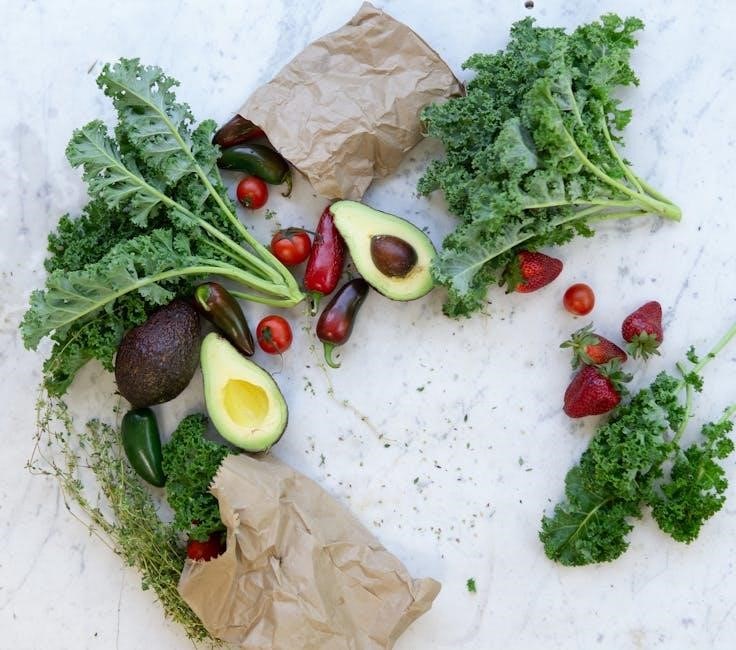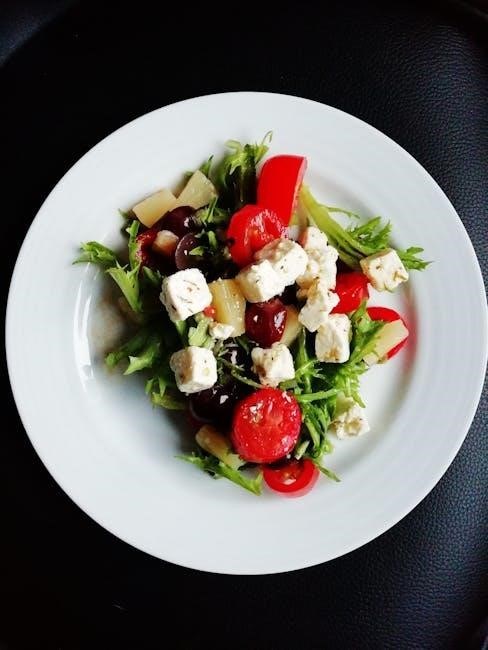Low GI foods‚ like whole grains‚ lean proteins‚ and non-starchy vegetables‚ are digested slowly‚ causing gradual blood sugar increases. They support weight management‚ blood sugar control‚ and heart health‚ making them ideal for balanced diets.
What is the Glycemic Index (GI)?
The Glycemic Index (GI) measures how quickly carbohydrate-containing foods raise blood glucose levels. It ranks foods on a scale from 0 to 100‚ with higher values indicating faster glucose release. Low GI foods (0-55) are digested slowly‚ causing gradual blood sugar increases‚ while high GI foods (70+) lead to rapid spikes. This index helps individuals manage blood sugar‚ energy levels‚ and weight by guiding food choices. Understanding GI is crucial for maintaining metabolic health and preventing chronic conditions like diabetes and heart disease. It empowers individuals to make informed dietary decisions for better overall well-being.
Why Low GI Foods are Important for Health
Low GI foods are essential for maintaining stable blood sugar levels‚ preventing sharp spikes and crashes. They promote sustained energy‚ reducing hunger and cravings. By slowing glucose absorption‚ these foods support weight management and improve insulin sensitivity‚ lowering diabetes risk; Additionally‚ they aid in heart health by reducing inflammation and cholesterol levels. Incorporating low GI foods into meals helps regulate metabolism‚ enhance digestion‚ and boost overall well-being. They are particularly beneficial for individuals with conditions like PCOS and coronary artery disease‚ offering a natural way to manage health and maintain a balanced lifestyle.

Benefits of a Low GI Diet
A low GI diet promotes weight management‚ stabilizes blood sugar levels‚ improves heart health‚ and provides sustained energy‚ supporting overall well-being and long-term health benefits.
Weight Management and Blood Sugar Control
Low GI foods help regulate blood sugar levels by slowing glucose release‚ reducing insulin spikes. This aids in weight management by curbing hunger and increasing satiety. Stable blood sugar levels support energy balance and prevent cravings‚ making it easier to maintain a healthy weight. For individuals with diabetes or prediabetes‚ low GI diets improve glycemic control‚ enhancing insulin sensitivity. Incorporating foods like whole grains‚ lean proteins‚ and non-starchy vegetables promotes sustainable weight loss and long-term blood sugar stability‚ benefiting overall metabolic health and reducing the risk of chronic diseases.
Improved Heart Health
Low GI diets promote improved heart health by reducing inflammation and enhancing cholesterol profiles. Foods with a low glycemic index help stabilize blood sugar and insulin levels‚ lowering the risk of cardiovascular diseases. Studies suggest that incorporating low GI foods‚ such as whole grains and non-starchy vegetables‚ can improve blood lipid levels and reduce blood pressure. This dietary approach supports overall cardiovascular well-being‚ making it beneficial for individuals at risk of heart disease. By choosing low GI options‚ individuals can contribute to a healthier heart and reduce the likelihood of developing conditions like hypertension and atherosclerosis.
Enhanced Digestion and Energy Levels
Low GI foods promote enhanced digestion and sustained energy levels by being digested slowly‚ preventing rapid blood sugar spikes. This gradual digestion reduces energy crashes and maintains steady vitality throughout the day. Foods like whole grains‚ lean proteins‚ and non-starchy vegetables are rich in fiber‚ which aids digestion and prevents issues like bloating or indigestion. The slow release of glucose ensures consistent energy‚ making low GI diets ideal for individuals seeking improved digestive health and long-lasting vitality. This approach helps avoid the energy fluctuations often caused by high-GI foods‚ supporting overall well-being and daily performance.

Understanding the Glycemic Index Scale
The Glycemic Index (GI) measures how quickly foods raise blood sugar. It ranges from 0-100‚ categorizing foods as low (0-55)‚ medium (56-69)‚ or high (70+) GI‚ guiding healthier choices.
Low GI (0-55)‚ Medium GI (56-69)‚ and High GI (70+)
The Glycemic Index (GI) categorizes foods based on their impact on blood sugar. Low GI foods (0-55) include whole grains like quinoa and barley‚ while medium GI (56-69) foods‚ such as certain cereals‚ cause moderate increases. High GI foods (70+) like refined sugars and white bread spike blood sugar rapidly. Understanding these categories helps in making informed dietary choices‚ especially for managing conditions like diabetes. Foods with lower GI values are generally recommended for sustained energy and better health outcomes. Always refer to reliable GI tables for accurate values‚ as some foods may vary based on preparation or serving size.
How to Interpret GI Values for Different Foods
Interpreting GI values involves understanding how foods affect blood sugar levels. Low GI foods (0-55) like quinoa and broccoli cause gradual increases‚ while medium GI (56-69) foods‚ such as certain grains‚ have a moderate effect. High GI foods (70+) like white bread spike blood sugar rapidly. When reviewing a list of low GI foods‚ focus on selecting items with lower values to maintain stable energy levels and support overall health. Combining foods with varying GI values can help optimize meal balance. Always consult reliable GI tables for accurate values‚ as preparation and portion size can influence a food’s GI rating.

Low GI Food Categories
Low GI foods include whole grains‚ lean proteins‚ non-starchy vegetables‚ and healthy fats. Examples are quinoa‚ chicken‚ apples‚ broccoli‚ and nuts‚ promoting balanced nutrition and steady energy.

Grains and Cereals
Whole grains like quinoa‚ barley‚ and bulgur are excellent low GI options‚ with GI values ranging from 20-55. They are rich in fiber and protein‚ promoting slow digestion and stable blood sugar levels. Rye crisp crackers and sunflower oat crisp crackers are also low GI choices‚ ideal for snacks. These grains help maintain energy levels and support overall metabolic health. Incorporating them into meals aids in weight management and improves insulin sensitivity‚ making them a cornerstone of a balanced low GI diet.
Proteins and Meats
Lean proteins like chicken‚ fish‚ and tofu are low GI options that stabilize blood sugar levels. These foods are rich in essential nutrients and amino acids‚ promoting satiety and muscle repair. Grilled or baked lean meats‚ such as turkey or pork tenderloin‚ are excellent choices. Plant-based proteins like lentils and legumes also fall into this category‚ offering sustained energy. Incorporating these proteins into meals helps regulate blood glucose and supports weight management‚ making them a vital part of a balanced low GI diet for overall health and well-being.
Fruits and Vegetables
Fruits like apples‚ berries‚ and citrus varieties are low GI options‚ providing natural sweetness and essential vitamins. Non-starchy vegetables such as broccoli‚ spinach‚ and bell peppers are also ideal‚ offering fiber and antioxidants. These foods slow sugar absorption‚ supporting blood sugar balance. Many fruits and vegetables are naturally low in carbohydrates‚ making them perfect for a low GI diet. Incorporating a variety of colorful options ensures a nutrient-rich meal plan‚ promoting overall health and glucose management without excessive blood sugar spikes.
Dairy and Alternatives
Dairy products like Greek yogurt‚ cottage cheese‚ and milk are low GI options‚ providing sustained energy and essential nutrients. Full-fat dairy tends to have a lower GI due to its fat content‚ which slows digestion. Plant-based alternatives such as almond milk and soy milk are also low GI and suitable for those with dietary restrictions. These options support blood sugar balance and offer versatility in recipes. Incorporating them into meals helps maintain stable energy levels and promotes overall health without causing rapid glucose spikes.
Snacks and Condiments

Low GI snacks and condiments are essential for maintaining blood sugar balance between meals. Nuts like almonds and walnuts‚ as well as seeds such as chia and flax‚ are excellent choices due to their slow digestion and nutrient-rich profiles. Condiments like hummus‚ mustard‚ and vinegar can enhance meals without spiking glucose levels. Snacks such as veggie sticks with hummus or low GI crackers provide satisfying options. These choices not only curb hunger but also support overall metabolic health‚ making them ideal for those following a low GI diet.
Specific Low GI Foods
Whole grains like quinoa‚ barley‚ and bulgur‚ along with lean proteins such as chicken‚ fish‚ and tofu‚ are excellent low GI options. Low GI fruits include apples‚ berries‚ and citrus fruits‚ while non-starchy vegetables like broccoli‚ spinach‚ and bell peppers are ideal. Healthy fats such as avocado‚ almonds‚ and chia seeds also fit into this category‚ providing sustained energy and supporting overall health.
Whole Grains (e.g.‚ Quinoa‚ Barley‚ Bulgur)
Whole grains like quinoa‚ barley‚ and bulgur are excellent low GI options‚ with GI values typically ranging from 20 to 55. These grains are rich in fiber‚ vitamins‚ and minerals‚ making them ideal for stabilizing blood sugar levels. Quinoa‚ a complete protein‚ is particularly beneficial for vegetarians‚ while barley and bulgur provide sustained energy due to their slow digestion. Incorporating these grains into meals helps regulate blood glucose‚ supports weight management‚ and promotes overall metabolic health. They are versatile and can be paired with lean proteins or healthy fats for a balanced diet.
Lean Proteins (e.g.‚ Chicken‚ Fish‚ Tofu)
Lean proteins like chicken‚ fish‚ and tofu are low GI foods that help stabilize blood sugar levels. Chicken and fish are rich in essential amino acids and omega-3 fatty acids‚ while tofu provides plant-based protein. These proteins are digested slowly‚ preventing rapid spikes in blood glucose. Incorporating them into meals supports weight management and improves insulin sensitivity. They are versatile and can be prepared in various ways‚ making them ideal for balanced diets. Pairing lean proteins with low GI vegetables or whole grains enhances their benefits‚ promoting sustained energy and overall health.
Low GI Fruits (e.g.‚ Apples‚ Berries‚ Citrus Fruits)
Low GI fruits like apples‚ berries‚ and citrus fruits are excellent choices for maintaining stable blood sugar levels. These fruits have a GI of 55 or below‚ meaning they are digested slowly‚ preventing rapid glucose spikes. Apples and berries are rich in fiber‚ which enhances digestion and satiety. Citrus fruits‚ such as oranges and grapefruits‚ are high in vitamin C and antioxidants. Many fruits with low GI values are also low in carbohydrates‚ making them ideal for weight management and improving insulin sensitivity. Incorporating these fruits into meals or snacks supports overall health and energy balance.

Non-Starchy Vegetables (e.g.‚ Broccoli‚ Spinach‚ Bell Peppers)
Non-starchy vegetables like broccoli‚ spinach‚ and bell peppers are low in carbohydrates and have a minimal impact on blood sugar levels. These vegetables are rich in fiber‚ vitamins‚ and antioxidants‚ making them a nutritious addition to a low GI diet. Broccoli and spinach are particularly high in fiber‚ which slows digestion and prevents rapid glucose spikes. Bell peppers add a burst of color and flavor while providing essential nutrients. These vegetables are versatile and can be incorporated into various meals‚ supporting weight management and overall health without raising blood sugar levels significantly.
Healthy Fats and Nuts (e.g.‚ Avocado‚ Almonds‚ Chia Seeds)
Healthy fats and nuts‚ such as avocados‚ almonds‚ and chia seeds‚ are excellent low GI options. Avocados are rich in monounsaturated fats‚ which slow digestion and stabilize blood sugar. Almonds provide a good source of protein and fiber‚ making them a satisfying snack. Chia seeds are packed with omega-3 fatty acids and fiber‚ further supporting blood sugar control. These foods not only add variety to meals but also contribute to heart health and satiety‚ making them ideal for a balanced low GI diet. Incorporating them helps maintain energy levels and supports overall well-being without causing blood sugar spikes.
Low GI Snack Options
Low GI snacks like nuts‚ seeds‚ veggie sticks with hummus‚ and low GI crackers provide sustained energy and stabilize blood sugar levels‚ supporting a healthy diet.
Nuts and Seeds
Nuts and seeds are excellent low GI snacks‚ offering sustained energy and rich in healthy fats. Almonds‚ chia seeds‚ and walnuts are top choices‚ with GI values ranging from 10-35. They provide essential nutrients like magnesium and fiber‚ supporting heart health and digestion. Portion control is key‚ as they are calorie-dense. Incorporating them into meals or snacks helps maintain blood sugar balance and enhances overall nutrition. Their slow digestion prevents rapid glucose spikes‚ making them ideal for weight management and metabolic health. They also promote satiety‚ reducing unnecessary hunger and cravings.
Vegetable Sticks with Hummus
Vegetable sticks paired with hummus make a nutritious‚ low GI snack. Carrots‚ cucumbers‚ and bell peppers are non-starchy vegetables with a GI of 30-45‚ while hummus‚ made from chickpeas‚ has a GI of 30-40. This combination provides sustained energy due to slow digestion. The fiber and protein in hummus help regulate blood sugar levels‚ making it ideal for weight management and blood sugar control. This snack is also rich in vitamins‚ minerals‚ and antioxidants‚ supporting overall health. It’s a filling and healthy option that promotes energy balance and satisfies cravings without causing glucose spikes.
Low GI Crackers (e.g.‚ Rye‚ Sunflower Oat Crisp)
Low GI crackers‚ such as rye or sunflower oat crisp‚ are excellent snack options with a GI of around 30-40. These crackers are made from whole grains‚ providing sustained energy due to their slow digestion. They are rich in fiber‚ which helps regulate blood sugar levels and supports heart health. Rye crackers‚ like Ryvita‚ are particularly popular for their low GI properties and nutty flavor. Pairing them with hummus‚ avocado‚ or lean proteins enhances their nutritional value. These crackers are ideal for those seeking a filling‚ low-GI snack that supports energy balance and overall well-being without causing blood sugar spikes.
Low GI Meal Ideas
Low GI meal ideas include oatmeal‚ Greek yogurt with berries‚ grilled chicken salad‚ quinoa bowls‚ and baked fish with steamed vegetables‚ promoting balanced energy and health.
Breakfast Options (e.g.‚ Oatmeal‚ Greek Yogurt with Berries)
Start your day with nutrient-rich‚ low GI breakfast options like oatmeal‚ which provides sustained energy due to its whole grains and fiber. Greek yogurt with berries combines protein and antioxidants‚ offering a balanced start. Scrambled eggs with spinach or avocado toast are also excellent choices‚ providing healthy fats and vitamins. These options help maintain steady blood sugar levels and keep you energized throughout the morning. Pairing these foods with a portion of nuts or seeds adds crunch and extra nutrition. A low GI breakfast supports weight management and sets the tone for a healthy‚ balanced diet.
Lunch Ideas (e.g.‚ Grilled Chicken Salad‚ Quinoa Bowl)
A low GI lunch can include options like grilled chicken salad with mixed greens‚ cherry tomatoes‚ and a light vinaigrette‚ or a quinoa bowl with roasted vegetables such as broccoli and bell peppers. These meals provide balanced nutrition‚ combining lean proteins‚ whole grains‚ and fiber-rich vegetables. Quinoa‚ being a complete grain‚ offers sustained energy‚ while grilled chicken adds essential amino acids. Non-starchy vegetables like spinach and cucumbers further enhance the meal’s nutritional profile. Pairing these with a side of avocado or a small portion of nuts adds healthy fats‚ ensuring a satisfying and energy-sustaining lunch.
Dinner Recipes (e.g.‚ Baked Fish with Steamed Vegetables)
Baked fish‚ such as cod or salmon‚ paired with steamed non-starchy vegetables like broccoli‚ spinach‚ or bell peppers‚ makes for a nutritious low GI dinner. Season the fish with herbs and lemon for flavor. Quinoa or barley can be added as a whole grain side for sustained energy. Incorporate healthy fats like avocado or a drizzle of olive oil to enhance satiety and nutrient absorption. This balanced meal supports blood sugar stability and provides essential vitamins‚ minerals‚ and omega-3 fatty acids‚ promoting overall health and satisfaction.

Expert Recommendations
Experts suggest portion control‚ combining high and low GI foods‚ and consulting a nutritionist for personalized plans to optimize blood sugar management and overall health benefits.
Portion Control and Balanced Meals
Portion control is crucial for maintaining a healthy diet. Even low GI foods‚ when overeaten‚ can lead to weight gain and blood sugar imbalances. Balancing meals with a mix of protein‚ healthy fats‚ and low GI carbohydrates ensures sustained energy and better glucose regulation. For example‚ pairing whole grains like quinoa with lean proteins such as chicken or tofu‚ and adding non-starchy vegetables like broccoli‚ creates a well-rounded meal. This approach helps in managing hunger and preventing excessive carbohydrate intake‚ promoting overall metabolic health and weight management. Consulting a nutritionist can provide personalized portion guidelines tailored to individual needs.
Combining Foods to Optimize GI
Combining foods strategically can optimize their glycemic impact. Pairing high-protein or high-fiber foods with carbohydrates helps slow digestion‚ reducing blood sugar spikes. For instance‚ adding avocado or nuts to meals lowers the overall GI. Similarly‚ pairing whole grains with lean proteins like chicken or fish balances glucose release. This approach supports better blood sugar control and sustained energy levels. Additionally‚ incorporating healthy fats and vegetables into meals further enhances the benefits of low GI foods‚ making each meal more nutritionally balanced and effective for overall health management.
Consulting a Nutritionist for Personalized Plans
Consulting a nutritionist is crucial for creating a personalized low GI diet plan tailored to your health goals and lifestyle. They can help you identify the best low GI foods‚ portion sizes‚ and meal combinations to optimize blood sugar control and weight management. A nutritionist will also provide guidance on balancing meals‚ incorporating variety‚ and addressing specific dietary needs. This expertise ensures you maximize the benefits of a low GI diet while maintaining nutritional balance. Their advice can simplify the process of selecting and preparing low GI foods‚ making it easier to adopt and maintain a healthier eating pattern.
Incorporating low GI foods into your diet promotes sustainable health benefits‚ including improved blood sugar control and weight management. Utilize resources like PDF guides for further exploration and balanced eating.
Final Thoughts on Incorporating Low GI Foods
Adopting a low GI diet offers numerous health benefits‚ including stable blood sugar levels and improved weight management. Start by identifying low GI foods like whole grains‚ lean proteins‚ and non-starchy vegetables. Gradually replace high GI options with these healthier choices. For guidance‚ refer to detailed PDF guides that list low GI foods‚ providing a clear roadmap for meal planning. Remember‚ small changes can lead to significant long-term improvements in overall health and well-being. Consistency and mindful eating are key to maximizing the benefits of a low GI lifestyle.
Resources for Further Reading and PDF Guides
For a comprehensive understanding‚ numerous PDF guides and resources are available online‚ detailing lists of low GI foods. These guides often include tables from the International Tables of Glycemic Index‚ providing detailed GI values for various foods. Examples include Sunflower Oat Crisp Crackers and Rye Crisp Crackers‚ which are highlighted as low GI options. Additionally‚ resources like “The Journal of Nutrition” and academic studies offer insights into the benefits of low GI diets. Websites such as Yandex Translate and DeepL also provide translation tools for accessing international low GI food lists‚ making it easier to incorporate these foods into your diet.

